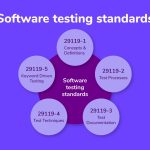Testing, Quality Assurance, and Quality Control
Most people get confused when it comes to pin down the differences among Quality Assurance, Quality Control, and Testing. Although they are interrelated and to some extent, they can be considered as same activities, but there exist distinguishing points that set them apart. The following table lists the points that differentiate QA, QC, and Testing.
| Quality Assurance | Quality Control | Testing |
| QA includes activities that ensure the implementation of processes, procedures and standards in context to verification of developed software and intended requirements. | It includes activities that ensure the verification of a developed software with respect to documented (or not in some cases) requirements. | It includes activities that ensure the identification of bugs/error/defects in a software. |
| Focuses on processes and procedures rather than conducting actual testing on the system. | Focuses on actual testing by executing the software with an aim to identify bug/defect through implementation of procedures and process. | Focuses on actual testing. |
| Process-oriented activities. | Product-oriented activities. | Product-oriented activities. |
| Preventive activities. | It is a corrective process. | It is a preventive process. |
| It is a subset of Software Test Life Cycle (STLC). | QC can be considered as the subset of Quality Assurance. | Testing is the subset of Quality Control. |
Audit and Inspection
Audit : It is a systematic process to determine how the actual testing process is conducted within an organization or a team. Generally, it is an independent examination of processes involved during the testing of a software. As per IEEE, it is a review of documented processes that organizations implement and follow. Types of audit include Legal Compliance Audit, Internal Audit, and System Audit.
Inspection : It is a formal technique that involves formal or informal technical reviews of any artifact by identifying any error or gap. As per IEEE94, inspection is a formal evaluation technique in which software requirements, designs, or codes are examined in detail by a person or a group other than the author to detect faults, violations of development standards, and other problems.
Formal inspection meetings may include the following processes: Planning, Overview Preparation, Inspection Meeting, Rework, and Follow-up.
Testing and Debugging
Testing : It involves identifying bug/error/defect in a software without correcting it. Normally professionals with a quality assurance background are involved in bugs identification. Testing is performed in the testing phase.
Debugging : It involves identifying, isolating, and fixing the problems/bugs. Developers who code the software conduct debugging upon encountering an error in the code. Debugging is a part of White Box Testing or Unit Testing. Debugging can be performed in the development phase while conducting Unit Testing or in phases while fixing the reported bugs.



Comments are closed